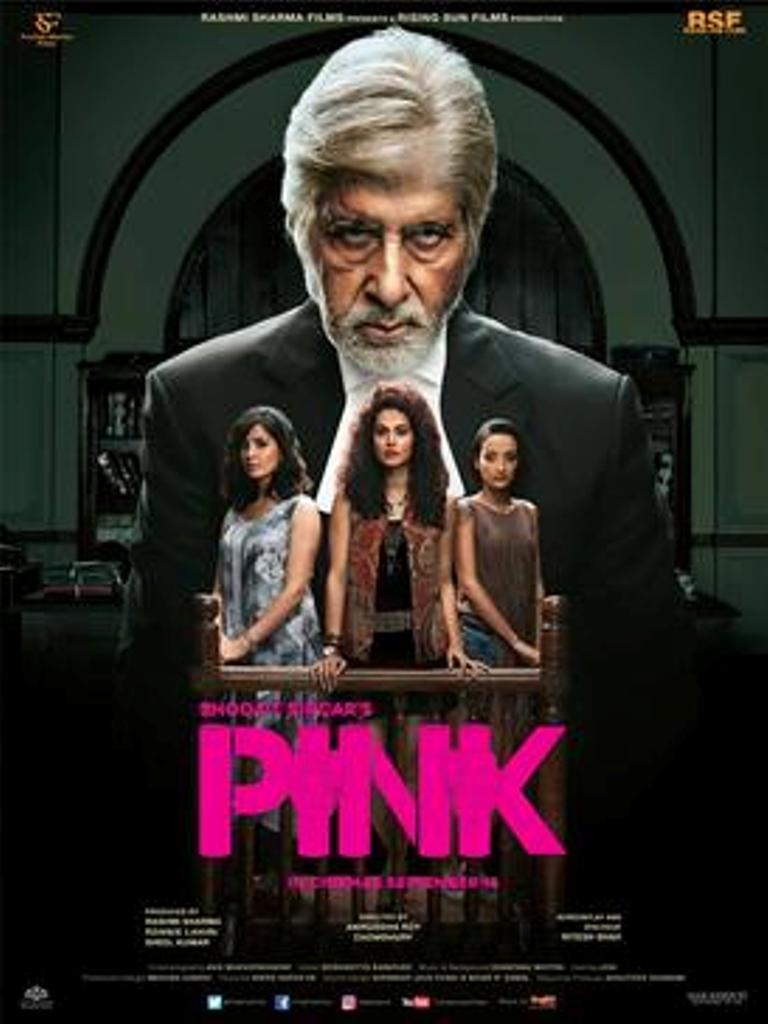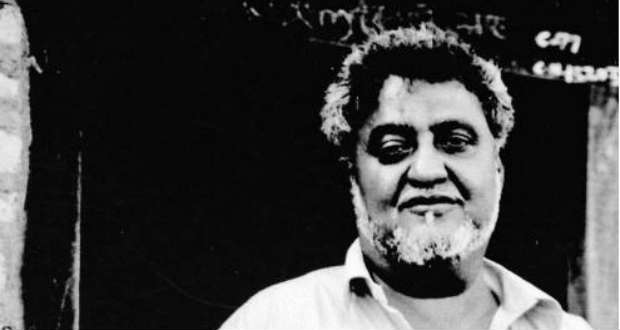Bobby Kunhu
The last time I critiqued a Bachchan starrer was without watching the movie, but this time the hype got me into the theatre to watch Pink. Truth be told, it was also way to spend time with a very close friend’s family. I would be lying if I said I didn’t enjoy the movie – I was angry, I cried – I had all emotions of a movie spectator watching a well crafted movie. But I walked out of the theatre with an uneasy feeling in the bottom of my stomach. I discussed this unease with my friend’s daughters – I don’t think they got what was gnawing me. The empathy with the raped woman and the anger with the rapist was complete – rightly so.

Then what is it that has left a bad taste in my mouth?
But before we venture into the movie itself, a brief diversion is required on what rape is and how it is understood and most importantly politically used. Though patriarchy would be the best word to start this note, I am deliberately omitting the word both because it is a given and also because lot of anti-rape voices do not seem to understand the connotations of the word – thereby increasing the propensity and occurrence of rape. Regardless of who it happens to, rape is perhaps the most violent offence – for many – more violent than murder itself. The motif of raped people committing suicide is a regular feature in Indian cinema. The following revenge usually involves equal brutalities. In Abu Ghraib what caught the attention and anger of the general public was not the general torture but the sexual humiliation and sodomy that the prisoners were subject to. So, the question we need to ask what is it that makes penetration of a object into a non sexual orifice like the nose less violent in public perception than the penetration of an object into a sexual orifice. Or to paraphrase what makes a sexual offence more repugnant in public perception than an equally brutal and humiliating non sexual violent act?
The root of the issue is that sex and sexuality (like every other issue that is hegemonised) is socially and legally seen as property – to be more specific heterosexual male property and a very important aspect of framing sex as property is the placing of it in a black and white box of the sacred and the profane – not as a bodily need that can vary from person to person. This makes a sexual violation more intrusive and traumatic as society takes the violated person right from the sacred box and places her in the profane box making rape a complex offence with actors other than the physical rapists also being complicit in the trauma of rape. With the efforts of the women’s movement – certain definitive changes in the law has happened, however at the societal and attitudinal level changes have been there – but cosmetic – for the boxes still exist.
Yes, a certain section of the middle class has started recognizing the possibility of heterosexual (preferably monoamorous) sexual independence of women – but strictly limited to that. Beyond that rape within the marital paradigm or commercial sex work would not even be recognized and this middle class is comfortable with that. The rapist has to be the typical “villainous” looking, preferably lower caste man. The outpouring of protests following Nirbhaya rape was precisely symptomatic of that.
What this has done in real and reel life is further invisiblise the majority of rape incidents. The latest National Crime Records Bureau data records 34,651 registered rape cases in 2015 of which 98% were committed by people known to the raped person and 59,277 cases of abduction, majority of them for marriage and therefore not considered rape. It is just the two percent that is presented before the public and causes popular outrage – be it Nirbhaya or Govindachamy. After all family needs to firmly remain in the sacred box and stranger rapists have to be profane!
What Aniruddha Roy Chowdhury and Ritesh Shah did was successfully tap into this new avatar of rape perception to create a movie – not about the raped person – but about the male savior of the raped person. Of course there are many firsts that the movie claims – not necessarily true. The raped woman is independent and likes partying and more importantly her drink and she is the supposed protagonist. In the process of creating and portraying this character – certain stereotypes are reinforced and denial of rights legitimized. Firstly the women most likely to be raped are independent, secondly they party and drink and thirdly they are out in the night. Well, Chowdhury and Shah are telling us that independent women who party and drink at night are the most likely to be raped. That is what Bollywood and popular patriarchal lore has been telling us all this while right?. The corollary being that women should not be independent, party, drink or have the right to public spaces at night. As an aside they also are reinforcing the predominantly South Asian myth that sexual activity is essentially nocturnal.
The risk paid with a post-Nirbhaya middle class audience – it struck a chord with them – the rapist is the other. In this case even though upper caste – he is related to a politician that neo-conservative India loves to hate. Whatever the location of the person, rape is deeply traumatic and I think Tapsee Pannu did a fairly decent job of portraying the trauma. But the movie was not about the character she portrayed or rape – more about that later, while we dwell a little more about the notions of rape that this movie invisibilises.
I will start with a quote from Dr. Rosenna Bakari, Professor of Psychology at Des Moines Area Community College and advocate for survivors of childhood sexual abuse:
“Society gives the image of sexual violators as weird, ugly, anti-social, alcoholics. Society gives the impression that violators kidnap children are out of their homes and take them to some wooded area and abandon them after the violation. Society gives the impression that everyone hates people who violate children. If all of these myths were true, healing would not be as challenging as it is.
Half of our healing is about the actual abuse. The other half is about how survivors fit into society in the face of the myths that people hold in order to make themselves feel safe. The truth is that 80% of childhood sexual abuse is perpetrated by family members. Yet we rarely hear the word “incest”. The word is too ugly and the truth is too scary. Think about what would happen if we ran a campaign to end incest instead of childhood sexual abuse. The number one place that children should know they are safe is in their homes. As it stands, as long as violators keep sexual abuse within the family, the chances of repercussion by anyone is pretty low. Wives won’t leave violating husbands, mothers won’t kick their violating children out of the home, and violating grandparents still get invited to holiday dinners. It is time to start cleaning house. If we stop incest first, then we will strengthen our cause against all sexual abuse.”
(As a diversionary note – I don’t agree with her view on incest. personally my problem with incest is the fiduciary nature of the relationship and this should extend to all fiduciary relationships – because sex in such relationships comes with the presumption of exercise of power – an inverse exercise of power in fiduciary relationship, though desirable is almost impossible)
The movie plays to this stereotype of the rapist. While your regular rapist looks no different from me and you. S/he could be your next-door uncle or even your dad. It is in the rare incident the rapist is a Govindachamy – but then it is easier to hate Govindachamy than your uncle or dad – because society dictates that they are people you should trust. The second most common occurrence of rape (that is missing in the quote) is in situations of social violence – in the Indian case caste and communal violence. Here too the rapist isn’t your evil anti-social alcoholic – he is one of us. The movie invisibilises all of these sexual violences and presents rape within a patriarchal framework that will make the audience comfortable with a rapist who is hateable and the raped person who is one of “us”.
The next problem with the movie is the claim that it is about the right of a woman to say no. Rapes do not happen at parties all the time – where the woman or for that matter man or child gets a chance to express her opinion on what is happening to her – expressly or indirectly. One of the most primary elements that constitutes rape is lack of consent – and lack of consent means “no”. It is the violation of that “no” in a sexual context that constitutes rape. The movie successfully sells the idea that it is the first to express this idea – which has been existing in the statute book for more than one and half centuries and in common sense since the beginnings of patriarchy.
To drive home the point let me draw a non-sexual analogy – but equally hegemonic. As early as 1860 it was legislated that “Whoever intentionally uses force to any person, without that person’s consent, in order to the committing of any offence, or intending by the use of such force to cause, or knowing it to be likely that by the use of such force he will cause injury, fear or annoyance to the person to whom the force is used, is said to use criminal force to that other” (Section 350 Indian Penal Code). The section is very clear and the consent is an important element in the definition of the crime. Despite this section (as well as Section 319 and 320 of the Indian Penal Code). It is considered “normal” for a parent or (till recently) teacher to hit a child ostensibly for the good of the child or for a husband to hit a wife. (There are numerous movies where the errant wife is reformed with a tight slap). Here the most occurrence of violence happens within the confines of either home or familiar domestic spaces. But popular culture will have us to believe otherwise – it is always the demonic other whose violence has to be deplored while the former is acceptable. Replace this violence with sexual violence and it becomes easier to grasp the problematic depiction of sexual violence in Pink!
There is mischief in the name “Pink” itself. “Pink”, like “Venus” is a patriarchal marker for feminity and control of non-male sexuality!
I assert that the film is not about rape. Then what is the movie about? The clue lies in the open letter that Amitabh Bachchan wrote and read out to his granddaughters. Before we get into the timing and the content of the letter itself, let us first do a brief examination of Bachchan’s gender politics. His wife, Jaya Bhaduri – who added the surname Bachchan – a very successful actor in her own times and on her own – cut her career short on the pretext of having to take care of her children after her first child Shweta was born. His daughter married into the Nanda family and the Managing Director of Escorts Ltd. does not have any public visibility – not even a wiki page to herself. Amitabh Bachchan is not known for having promoted any gender cause at any point of time in his career and moreover Amitabh Bachchan is not known for having any sort of political stand except for what he is paid for. Shashi Tharoor’s novel “Show Business” parodies Bachchan’s greed for money very well – so much so – as a friend put it – for the right amount of money he would even let himself be captured in the loo on camera!
{youtube}pkVcNQXZv9U{/youtube}
So this movie is not about rape, then what is this movie about? The clue is in the public open letter that Bachchan wrote and broadcast for his granddaughters as part of the promotions for the film, as I said earlier. The film is about an upper caste man Deepak Sehgal and his values that he wants the society to emulate – like the open letter! Before we continue we need to take a quick peek into this open letter (which has already been torn into pieces by feminists in social and mainstream media. To sum up – the letter is castiest and misogynist and that it was broadcast makes it even more disgusting. The surnames Bachchan and Nanda are thrown at your face right in the beginning and serves as punctuating marks through the letter – the subtext being you are a Bachchan and a Nanda and you better live up to the names – with all nice sounding platitudes – even the upper caste women of the family with all their achievements are invisible in the letter – not only the women, but also the patriarchs in their family. So the granddaughters need to carry the legacy of Bachchan and Nanda – but not necessarily Bhaduri and Kapoor (equally upper caste)! And the letter seems to imply that women without surnames or “bad” surnames are just that – don’t deserve to be visible or make a choice! More importantly they don’t deserve to be talked about – they don’t fetch the bucks in the box office!
In many ways the letter reflects the film – it conveniently leaves out the fact that the primary site of oppression of women is the family and the blame is put on the convenient demonized other who is easy to hate. Career, marriage or sexual decisions of women are controlled by the family – not by the mythical “log” that Bachchan invokes in his letter. In fact the mythical “log” is invoked by the family as a weapon to control women. Decisions on female feticide and infanticide is taken by the family – not by “log” – “log” may play a role in shaping the moral attitude behind these decisions, but they do not kill the female fetus or infant. Forced marriages and honour killings are carried out by the family – not by “log” (though in some cases “log” might participate). The skirt length comment in the letter was below the belt – it sounded like a fair and lovely advertisement. But then nothing more can be expected because this letter was no genuine political outpouring, but a promotional stunt and had to reflect the movie.
Coming back to the movie – it can be summed up as the story of how three women are cornered and framed and when they are at their wit’s end and cannot take the fight forward – the upper caste man with all his caste values including a much married wife to whom he is alluded as being faithful to – and on whose instigation – steps in to get justice for these embattled and battered women. This is no new motif in Bollywood and has been repeated ad nauseam – where the male protagonist arrives at the scene to save or deliver justice to the oppressed female character. So, what Chowdhury and Shah have done is serve stale food in designer cutlery and fooled the audience into believing that they are consuming a culinary invention!
But not everything was bad about the movie. It did have its moments. I, for one am yet to see an Indian movie depict trial courtroom scene even to the remotest exactitude – because trial lawyering is an extremely exacting and technical process lacking drama and I suppose cinema requires drama. This movie was no exception and the trial court room was made to fit the cinematic aesthetic of the courtroom. But, the redeeming factor and an important one at that is that it showcased the harassment, insensitivity and sheer bullying towards any raped person by the state machinery including the judiciary fairly well and with sensitivity. The cinematography and editing was also technically sound. But none of this redeems the atrocious scripting and sale of regressive misogynist caste chauvinism as progressiveness.
Tailpiece: Another thing that piqued me a lot about the movie was the portrayal of the character of Deepak Sehgal as someone with bi-polar disorder with wild mood swings. The portrayal was like adding salt to an open wound – especially for me who has been undergoing treatment for depression and whose best friend is diagnosed with bi-polar disorder and has been on medication for years together now. The portrayal of Deepak Sehgal parodies a serious mental health condition. At best Deepak Sehgal’s character reminds one of a voyeur who is interested in everyone else’s business instead of being in the hospital with his ailing wife.
End of the day – it is “Pink” that heterosexual men fantasize and attribute to women that is sought to be protected, not any other colour!
~~~
Bobby Kunhu is a human rights activist and lawyer.
Image and video courtesy: the internet.










